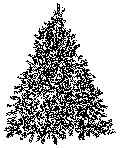Pick Your Own Jersey Fresh Christmas Tree at a Tree Farm Near You!
| For Immediate Release: December 17, 2001 | Contact: | Hope Gruzlovic
|
Acting Governor Donald DiFrancesco joined New Jersey Agriculture Secretary Art Brown, Jr., today at McLaughlin's Tree Farm in Somerset to remind residents of the Garden State that a Jersey Fresh Christmas tree is the best tree they can buy for their families. To prove the point, DiFrancesco and Brown harvested two beautiful trees, one of which will go to the Cancer Concern Center in Point Pleasant Beach and the second one will go to the Central Jersey Oncology Support Group in New and East Brunswick. Accepting on behalf of the Cancer Concern Center was Don Glazier, whose wife Sandy, who helped to found the group, while Richard Sherwood and Meghan Coleman accepted on behalf of the Central Jersey Oncology and the Support Group. "Recent national events have really underscored the importance of friends and family and the valuable legacy family traditions provide," DiFrancesco noted. "For many New Jersey families, visiting a Jersey Fresh Christmas tree farm and picking out a tree to harvest is an important part of their Christmas celebration." DiFrancesco urged families who still haven't found their tree to visit the New Jersey Christmas Tree Growers' website, WWW.NJCHRISTMASTREES.ORG, to find farms near their homes where the entire family can select a tree, the youngsters can chat with Santa and young and old can enjoy seasonal music and refreshments. Brown heartily seconded the Acting Governor's suggestion and added some practical observations about Christmas tree production in New Jersey. "The Garden State has over 200 commercial Christmas tree farms which produce hundreds of thousands of trees," Brown noted. "Christmas tree farmers treat the trees just like any other crop. Christmas trees are planted, sheared and cultivated for harvest in the fall. Wherever a tree is cut or lost to insects, diseases, wildlife or other factors, two or three new seedlings are planted for future harvest." In addition to providing the seasonal greenery we've all come to love, Brown said Christmas tree farms also provide greenbelts throughout the state that refresh the atmosphere and provide habitat for a wide variety of wildlife and migratory birds. Christmas trees also cleanse the air that we breathe by consuming huge amounts of carbon dioxide and reintroducing large quantities of oxygen into the atmosphere. Greg and Deb McLaughlin hosted this year's tree-cutting event. McLaughlin is the 2001 winner of the Fred E. Johnston Grand Champion honor. This is awarded annually by the New Jersey Christmas Tree Growers' Association to the tree farmer placing Best in Show at their Christmas tree competition which held this year at the Middlesex County Fair. He has about 12,000 trees in production on the leased farm and, although he's been selling choose-and-cut trees since 1999, this season marks the grand opening of the main fields. McLaughlin also offers Christmas music and refreshments, wreaths, roping, and other seasonal decorations as well as balled-and-burlapped trees for those who want to plant the tree after Christmas is over. Tree cutters will cut and bale trees for customers (free of charge) or they can do it themselves. The farm is open from 10 am to dark on weekends from December 1 through 23. The 185-acre farm has been family-owned for decades, first producing chickens and eggs and later grain crops and the Christmas trees. Although family records for the farm date back to 1912, it has been farmed since 1862 and served as home to Native Americans even before that. McLaughlin met the current owners of the farm, sisters Melba Battin, Ada Ferraro and Rena Marter, in 1991. They were interested in farming new and different crops in order to keep the farm viable for the long term. McLaughlin and the sisters developed a long-term lease arrangement that gave all parties the security of knowing the farm would stay productive for many years. In 1992 McLaughlin planted approximately 3,000 evergreen seedlings and has planted between 3,000 and 5,000 more each year. He recently helped the owners enroll their woodland in the Forest Stewardship Program through which they have improved habitat for wildlife and planted trees to reforest some field areas. The landowners have also put a portion of their farm into the Farmland Preservation Program. McLaughlin gained his agricultural experience by working part-time during college on a farm. After graduating from Rutgers with a BS in Forest Management and an MS in Plant Biology (thesis focus on Christmas tree production and culture), McLaughlin spent several years as a Program Associate in Forestry for Rutgers Cooperative Extension, doing research and management of Christmas tree plantations for Rutgers and private cooperator farms. The two groups who received the trees harvested by DiFrancesco and Brown offer a wide variety of support services to cancer patients, their families and friends, ranging from help with day-to-day activities like housecleaning and meal preparation to transportation to medical services, from yoga classes and therapeutic massage to emotional support and strong shoulders. The Support Group was founded in June 2001 by Meghan Coleman, RN, MSN, APNC, to help patients and their loved ones cope with cancer. Bi-monthly hour-long discussion groups rotate from New Brunswick to East Brunswick locations and offer comfort, self-realization, education and emotional support. The Cancer Care Center opened in September 1998 with a variety of private donations and is run by an all-volunteer staff. One of the Center's co-founders, Sandy Glazier, recently passed away but her hope of providing a strong support system for other cancer patients and their families lives on. Select a tree with the height, shape and density that best suits your needs. Think about where it will be located in your home and the kind of ornaments you have (large and heavy or small and light-weight). Remember, in the field, the sky is the ceiling so trees always appear smaller than they actually are! Keep your holiday a safe and enjoyable one. Avoid combustible decorations. Discard frayed light strings and those with worn spots and use only U.L. approved lights. Turn off the lights when you go to bed or if you leave the house. Before bringing the tree indoors, put it in a waterproof container, such as a washtub. To stabilize it, put sand or gravel in the container around the root ball. Keep root ball moist. A 5' to 6' foot tree may take as much as a quart of water daily. It's best not to keep a dug tree indoors for more than one week. After its decorations are removed, gradually introduce it to the colder temperature by first placing it in a cooler, sheltered area for several days. If the root ball is covered in plastic, handle it the same way except that, before planting, cut slits on the bottom half of the plastic to insure drainage and root penetration. Water it thoroughly and put mulch on top of the bare soil. CHRISTMAS TREE TRIVIA The first Christmas tree dates back to 16th century Germany. |
 Official Site of The State of New Jersey
Official Site of The State of New Jersey






